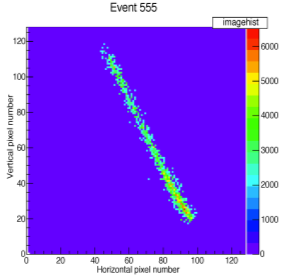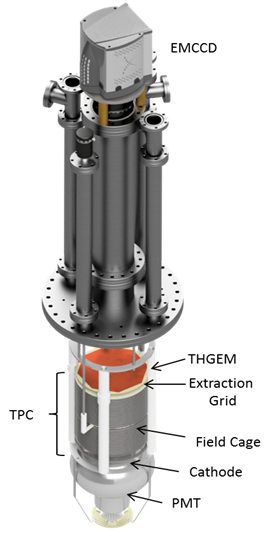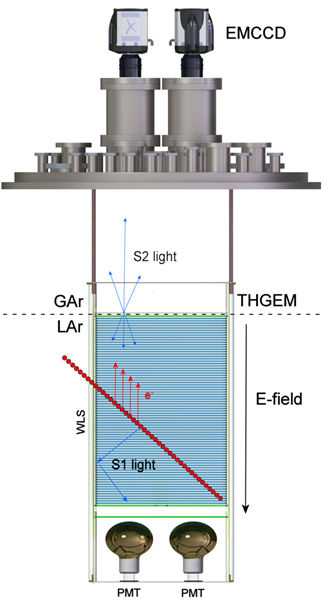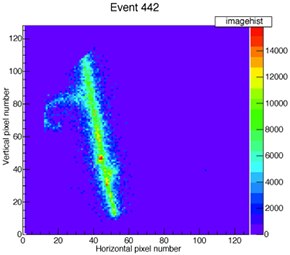Resources
 Part of the Oxford Instruments Group
Part of the Oxford Instruments Group
Expand
Collapse
 Part of the Oxford Instruments Group
Part of the Oxford Instruments Group
Particle physicists are investing a lot of research effort on the study and characterisation of one of the most intriguing of the fundamental particles in the universe – the Neutrino. It is with a view to unravelling answers to some of the ‘big’ outstanding questions on the fundamental nature of the universe such as dark matter and the matter/anti-matter imbalance [1-3].
One of the most challenging if not the most challenging aspects of this work is the ability to detect the particles in the first place. This application note describes the work of a group at the LAr Facility of Liverpool University who are developing a novel approach to the detection of such particles using EMCCD technology. They are using imaging cameras to detect optical emission from secondary scintillation processes produced as a result of particles passing through the particle detector [4]. They have already built a detector and carried out ‘proof-of–concept’ investigations [4] with very impressive results.
Now they are developing a much larger scale instrument to be used for research on a charged particle beamline at CERN [5]. The instrument is called ARIADNE – a name which resonates with a Greek mythological goddess who is associated with many intriguing encounters – but in this case is derived from “ARgon ImAging DetectioN chambEr”. The detector is based on the latest developments of Time Projection Chamber (TPC) technology.
Introduction

Figure 1: Image captured on an EMCCD camera of a scintillation track derived from a sub-atomic particle as it passes through liquid Argon in a TPC.
Neutrinos are among the most fundamental particles in the universe, with such copious amounts that over a trillion neutrinos pass through our bodies every second. Their interaction with matter is so minimal that they pass unnoticed and harmlessly through everything including the earth. Consequently whilst posing no danger, they are extremely difficult to detect. A neutrino has no electric charge and has a mass more than a million times less than that of an electron. Of the little that is known about neutrinos, they have been observed to exist in three states or ‘flavours’ and they can transform or change between these states or ‘flavours’. Up to this point what is called ‘The Standard Model’ theory has been very successful in explaining much of fundamental particle physics. However, it has certain shortcomings and this observation on neutrinos is one of them.
The Standard Model does not explain certain phenomena such as dark matter, dark energy and the observed matter–antimatter imbalance in the Universe. It is one of the main goals of particle physicists to explore the physics beyond the Standard Model and Neutrino particles offer the means to probe this domain of nature.
Neutrinos are produced in such cosmic events as exploding stars and colliding black holes, and can be subsequently observed here on earth. However, they can also be produced here on earth using high energy particle accelerators/colliders such as those at CERN and Fermilab, where beams of protons are accelerated to speeds comparable with that of light before being collided into targets such as graphite. The fast protons interact with the nuclei of the target material producing intermediate sub-atomic particles which decay on short timescales resulting in the production of neutrinos along with other fundamental particles.
Detection of sub-atomic particles is very difficult with neutrinos being particularly challenging. Most current detectors use Time Projection Chambers (TPC) containing large volumes of liquid Argon with an electric field applied across it as the primary stage of the detection process. The higher density of Ar increases the chances of detecting events compared with earlier gaseous systems. The ionisation properties of Ar (as a noble material), its density and its availability are key advantageous of Argon. Liquid Argon - Time Projection Chambers (LAr-TPC) are establishing themselves as the preferred form of detector for neutrinos: these were first developed by Carlo Rubbia in the 1970s [6]. The LAr-TPC particle detector enables the 3D reconstruction of the particle tracks through the detection medium.
The LAr-TPC detector at Liverpool

Figure 2: A schematic picture of the ‘demonstrator’ detector at the Liverpool LAr Facility
A schematic showing the main components of the ‘demonstrator’ LAr-TPC particle detector at Liverpool is shown in figure 2. This was developed to demonstrate the first use of an EMCCD to image cosmic muons in a LAr-TPC [4]. The main components of this ‘two phase’ LAr-TPC can be listed as:
All of these components apart from the EMCCD are contained within the cryostat environment. The role played by the different components and what is captured on the EMCCD is described in more detail below. An image derived from a typical event or particle passage through the chamber is shown in figure 1. A combination of the spatial and temporal information from the electronic signals collected at the output of the segmented THGEM, PMTs, and EMCCDs allows for the 3D reconstruction of the particle tracks through the liquid Argon detection medium. This work set out to demonstrate that optical imaging of the output scintillation from the THGEM could be used as an alternative to a large number of the charge signals.
The question arises as to why use imaging in the first place as an alternative to the established charge readout approach. The group point out that the advantage will come in terms of scalability and the impact on complexity, effort required and ultimately costs. Adding more and more charge readout channels and electronic connections for the larger anodes results in increased complexity and costs, whereas the modular approach with EMCCD sensors could offer a much less troublesome and more cost-effective route.
ARIADNE – the new large-scale LAr-TPC detector

Figure 3: A section through the new LAr-TPC particle detector at Liverpool which will incorporate the use of 4 EMCCD detectors.
Based on the results from the demonstrator the Liverpool group are now developing ARIADNE which will have four EMCCD cameras for imaging. The design is based on a scaling up of the size of the overall detector and the use of multiple cameras to increase the effective imaging area. Figure 3 shows a sectional cut through the new detector with the main components evident as listed above. The functions of the different components are described in more detail here.
The neutrino particles upon interaction with Argon produce secondary charged particles resulting in ionisation of the Argon atoms [7]. The electrons produced drift under the influence of a uniform electric field towards an anode where there may be various technologies for collecting, amplifying and reading out the charge. The track of the incident particle is shown as the red line in the diagram.
There are two main designs for LAr-TPC detectors referred to as ‘Single Phase’ and ‘Double Phase’ depending on the readout method used. In the single-phase, the electrons drift through the liquid Argon to the collection plane of the anode where the induced current signal is read out. In this case the anode consisting of a wire assembly is immersed at the top of the liquid Argon. In double-phase systems there is an additional medium of gaseous Argon (the ‘second phase’) through which the electrons pass before readout. A high voltage anode electrode at the top of the liquid Argon extracts the electrons into the Argon gas. A multiplication device called a Thick Gas Electron Multiplier (THGEM) interfaces with the gaseous Argon and with the use of a high voltage amplifies the electron signal at this point. In the current double phase detectors, the resulting charge is collected by a segmented anode at the top of the gas chamber and is read out as a transient voltage signal.
The uniformity of the electric field is of critical importance in ensuring the accuracy of reconstructing the particle path and extracting energy information. To ensure this, a ‘field cage’ consisting of conduction bands is wrapped around the Argon containing chamber. The field cage is shown in blue in the figure.
The charged secondary particles involved in the ionisation process of Ar also cause the liquid Argon to scintillate producing light in the UV. This light is detected by the embedded photomultiplier tubes (PMT) at the base of the detector and this signal is used as a timing reference to mark the start of an event. This occurs on the order of a few nanoseconds which is much shorter than the typical time for the generated electrons to drift through the system to the anode readout nodes. This scintillation light is referred to as ‘prompt scintillation’ here and is denoted by S1 in the diagram.

Figure 4: Typical 2D image captured on an EMCCD of the secondary emission derived from the passage of a cosmic muon through the LAr-TPC detector.
Avalanches of electrons are produced in the THGEM when the multiplication process takes place; the gain is dependent on the voltage applied across the ‘tubes’, or ‘channels’ of the THGEM structure. Interestingly (and importantly in this case) secondary scintillation emission occurs as a result of electroluminescence when the avalanche electrons interact with the Argon gas. This is where the novel use of high sensitivity EMCCD cameras can come into play. The emitted light, denoted by S2 in the figure, is detectable by both the EMCCD arrays and the PMTs at the bottom of the LAr-TPC. The camera captures 2D images of this emission as illustrated in figures 1 and 4.
The pulses from the PMTs, the electronic signals from the segmented THGEM and the 2D images allow for the reconstruction of the 3D tracks and also the extraction of calorimetric information on the energy of the particles.
The Liverpool LAr Neutrino group have successively demonstrated how the acquisition of optical images from the scintillation output from the THGEM device in LAr-TPC particle detectors can offer an alternative means for capturing the necessary information, along with that from the PMTs and THGEM charge electronics, to reconstruct the 3D tracks of sub-atomic particles. EMCCD technology in the form of the IXon 888 offers the high sensitivity and sensor area which are key requirements. With low noise performance and the availability of EM gain, these cameras can make highly sensitive measurements of extremely low signals. Their approach offers a cost-effective and elegant alternative to current technologies when facilitating the development of ever larger scale instruments. ARIADNE will be used at a charged particle beam at CERN to allow for characterisation of its calorimetric and particle identification capabilities.
Acknowledgement
The information and figures for this note have been gratefully received from Dr K Mavrokoridis of the LAr Facility at the University of Liverpool.
References
